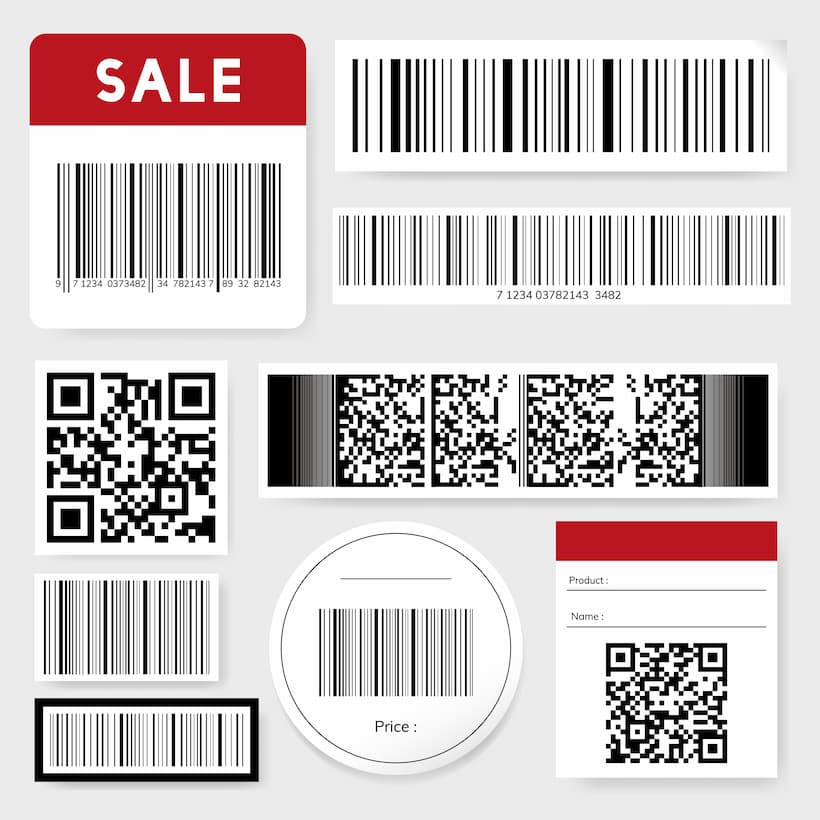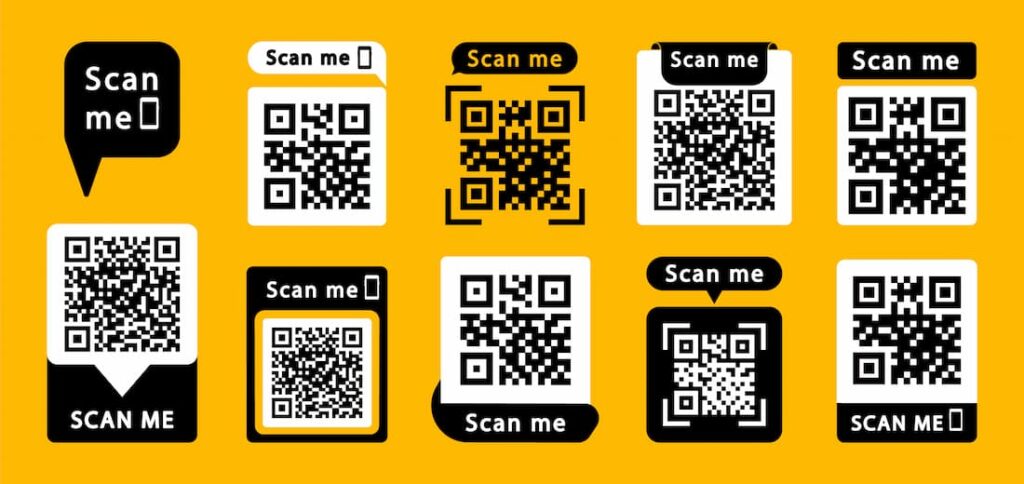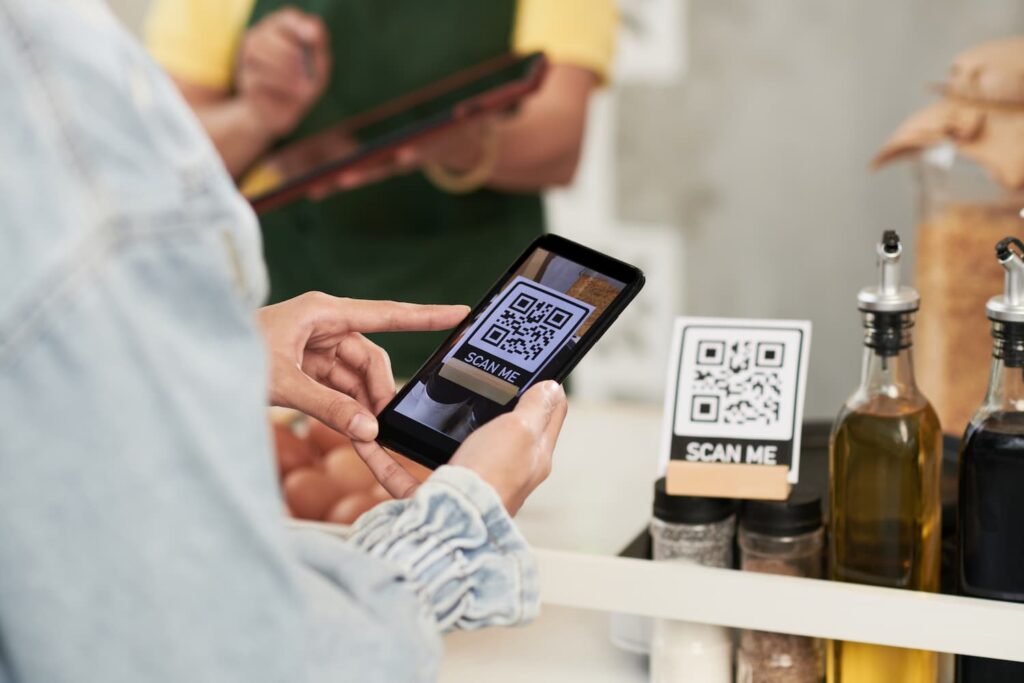
Both types of codes offer great functionalities and have embedded themselves in our everyday life —from business applications to personal use.
But what are the main differences and applications? What are the advantages when it comes down to choosing one over the other? Are QR codes going to replace barcodes?
Let’s take a look at both codes to answer these and other questions in this exciting duel between the barcode and the QR code system!
Table of Contents
- What is a Barcode
- What is a QR Code
- Differences Between Barcodes and QR Codes
- How to Scan Barcodes
- How to Scan QR Codes
- FAQs
- Wrap-Up
What is a Barcode
According to Denzo Wave, a barcode —not “bar code”— is a machine-readable representation of numerals and characters. It comprises parallel lines of varying widths that can be read with optical barcode readers.
Joe Woodland invented the barcode in the early 1950s and it was based on Morse code. Ever since it flooded nearly every aspect of industry and modern life. It’s used as a control and identification method for products.
There are one-dimensional barcodes and others are two-dimensional. The former can be scanned with any laser barcode scanner, and the latter with an imager only.
Barcode’s main components include:
- Quiet zone (blank margin located at either end of a barcode.
- Barcode symbol
- Start character (the first character in the sequence below the bars)
- Data message (the following three characters)
- Check digit (the penultimate character)
- Stop character (there last character in the sequence)
There are several types of barcodes, each one with symbol variations.
- EAN (JAN): They display only numerals (0 to 9) and are the most commonly used for products. Compativle with EAN in Europe and UPC in EE.UU.
- Interleaved 2 of 5: They also use numerals (0 to 9) and are the standard distribution code. Very common in logistics.
- Codabar (NW-7): It uses numerals (0 to 9), symbols, and start-stop characters (a to d). It can be easily printed and is mainly used for shipping labels, envelopes, and laboratory samples.
- CODE 39: It comprises numerals, symbols, alphabetical letters, and start-stop characters. They are commonly used in factory automation.
- CODE 128: These codes use all 128 ASCII characters, 3 start characters and 1 stop character, 4 non-data function characters, and 4 code setting selection characters. Mostly used for electronic part management.
What Are Barcodes Mostly Used For?
Barcodes have several applications.
- Logistics: From tracking, shipping, and storage, barcodes help industries keep track of their products and are often used for inventory management.
- Retail: This industry uses barcodes to identify products in storage and during payments.
- Healthcare: Hospitals use barcodes to identify patients and medical treatments.
- Airline luggage: Carriers use barcodes to help track and identify luggage.
What Are the Advantages of Barcodes?

Accuracy: As barcodes prevent human mistakes, which can happen when manually entering data, they offer a high level of accuracy in data collection.
Speed: Because barcode scanning is quick and effective, a large number of transactions may be handled without delay.
Cost-effective: Barcodes are a cost-effective solution for companies of all sizes since they are easy to create and use. Barcodes give organizations the ability to track their inventory levels in real time, which lowers the danger of stock shortages and overstocking. This results in improved inventory control.
Improved customer service: Businesses can more easily provide tailored service by using barcodes to instantly obtain consumer information.
What Are the Disadvantages of Barcodes?
Restricted data: Barcodes normally only hold a few pieces of data, like a serial number or a product code. Additional labels or tags may be needed for information that is more specific.
Damage-prone: Scratches or damage to barcodes can render them illegible, which can compromise the accuracy of data collecting.
Technology dependency: Barcodes need specialized hardware, like a barcode scanner or mobile device, which may not be accessible or compatible with all systems.
Barcodes are easily copied, thus if they aren’t properly secured, they could be used for fraud or counterfeiting.
Environmental impact: Non-biodegradable materials, which are frequently used to make barcodes, can add to trash and pollution if improperly disposed of.
What is a QR Code

QR codes are basically 2D codes and their name means “quick response code.” They appear in 1994 as an evolution of the traditional barcode.
Only one QR code can store several pieces of information in almost every format —text, video, sound, URLs, etc.
The information is available via a QR code reader, such as a mobile application or a phone’s main camera.
Static QR codes can store multimedia data, which can never be edited or deleted; meanwhile, the information contained in dynamic QR codes can be edited as many times as needed.
Dynamic and Static QR code differences
Content: Static QR codes contain fixed information that cannot be changed once the code is generated. Dynamic QR codes, on the other hand, can be modified and updated even after they are printed or distributed.
Tracking: Dynamic QR codes can be tracked and analyzed to collect data on how many times they have been scanned, where they have been scanned, and by whom.
This allows businesses to monitor the effectiveness of their QR code campaigns and make data-driven decisions to improve their marketing strategies. Static QR codes cannot be tracked in this way.
Size: Static QR codes tend to be smaller in size than dynamic QR codes. This is because dynamic QR codes require extra space to store the information needed to update the code later.
Customization: Dynamic QR codes are more customizable than static QR codes. With dynamic QR codes, you can change the design, color, and logo of the code to match your branding.
You can also add custom call-to-action (CTA) buttons to encourage users to take a specific action after scanning the code.
Overall, dynamic QR codes offer more flexibility and tracking capabilities than static QR codes, making them a better choice for businesses.
However, if you only need to store fixed information, such as a website URL or contact information, a static QR code may be sufficient.
People can create both QR codes for several uses with QR code generators like QR.io. These codes can be customized and offer a myriad of possibilities to share content such as social media profiles, review forms, YouTube videos, MP3 maps, locations, PDF files, and much more. The uses in marketing campaigns are almost endless!
QR Code Use
QR codes are very versatile and can be used in many ways:
Share links: With a multiple links QR code, people can create codes to share any URL —for a web page, a social media profile, a document’s link, etc.
Send emails: With just one scan, you can send an email with a QR code for email and get in contact with e.g. customer support.
Make phone calls: With a QR code for calls, it’s just as easy as scanning a code that redirects to a phone number that you can dial.
Send SMS: The QR code text message is absolutely convenient to send preset text messages so no one has to type it manually!
Share WhatsApp contacts: You don’t want people to have to type in your number, save it, and then open it on WhatsApp? A WhatsApp QR code will open the chat window in one scan.
Connect to Wifi: QR codes allow users to connect to internet networks without the need to search for the name and ask for the password.
Share PDF files: From a business presentation to a restaurant menu and instruction manuals, the QR code for a PDF connects users with a versatile document format.
Share images: With just one scan of the QR code for photos, people can access whole image galleries that can later be saved on their mobile devices.
App downloads: With QR codes for apps, developers can promote their apps by allowing potential users to download them instantly with just one scan.
Share MP3 files: With music QR codes, promote your music or share that track that you like with just a scan.
Advantages

Quick and simple: Without the need for manual data entry or typing, consumers can access information via QR codes swiftly and simply.
Large capacity: QR codes are beneficial for a variety of applications since they can hold a lot more data than standard barcodes.
Versatility: QR codes are used in many contexts, including product labeling, promotional materials, event tickets, and more.
Trackable: Marketing and business analytics may benefit from the ability to track user behavior and customer interaction using QR codes.
Enhancing the consumer experience: QR codes can be used to give clients more information about goods or services, as well as to offer discounts and exclusive promotions.
Cost-effective: QR codes can be generated and printed inexpensively, making them a cost-effective way to provide additional information to customers.
Contactless: Scanning QR codes can be done from a distance, reducing the need for physical contact and improving hygiene and safety in public settings.
Disadvantages
Limited adoption: Despite their widespread use in some countries, QR codes are not yet universally adopted. This limits their usefulness in some markets or regions.
Required technology: QR codes require a smartphone or other device with a camera and a QR code scanning app, which not all users may have.
Dependence on Internet connectivity: QR codes often require Internet connectivity to access the information they contain, which can be a problem in areas with poor or no network coverage.
Potential misuse: Like any other technology, QR codes can be used to direct users to inappropriate or offensive content, which can be a concern for businesses and organizations using them in marketing campaigns.
Differences Between Barcodes and QR Codes
Barcode and QR code differences are pretty significant:
- QR codes have more storage capacity when compared to barcodes.
- Barcode use is limited to industry and business applications, while QR codes have both industrial and personal applications.
- Anyone can create QR codes, while barcodes need special software.
- QR codes can be customizable and editable —if they are dynamic. By creating an account on QR.io, you can access, personalize, and edit the dynamic QR code as many times as you want.
- QR codes can be up to 10 times smaller than barcodes and still be scannable. This means a smaller size and more information.
- Barcodes are harder to read with a barcode scanner, while QR codes can be scanned from different angles.
- QR codes are more resistant and can continue to work even when they’re broken to some extent.
- Storing data: Barcodes store data in parallel lines, while QR codes store information both vertically and horizontally
How to Scan Barcodes

You must use machines that read barcode data representation, or barcode scanners. You must aim the red laser at the barcodes and press the scanner’s button.
When using a flat scanner, just swipe the barcode across the flat scanner’s surface. Most scanners will beep once your scan has been registered.
How to Scan QR Codes
Use a QR scanner —a QR scanning app or a smartphone camera— and point to the QR code. A frame will appear around the corners of the QR code, followed by a banner, which you would want to tap. Once you do this, the information will appear on the screen.
FAQs
Will QR codes replace barcodes?
The sheer convenience, versatility, and storage capacity of QR codes will continue to push aside the barcode gradually. However, barcodes are unlikely to disappear since they’re perfect to store simple information.
Barcodes and QR codes: Which is faster to read?
Since QR codes are easier to scan by being 2D in nature, they are faster than barcodes. QR codes rely on short URL technology, which makes the information load way faster in comparison
Wrap-Up
Barcodes are part of our everyday life but we don’t notice it. However, QR codes are flooding the world and we are aware of their presence nearly every day, in every interaction with people and businesses.
Although barcodes are yet to disappear, QR codes pack much more punch and are so accessible that you only need to use a QR code generator and create codes yourself!
